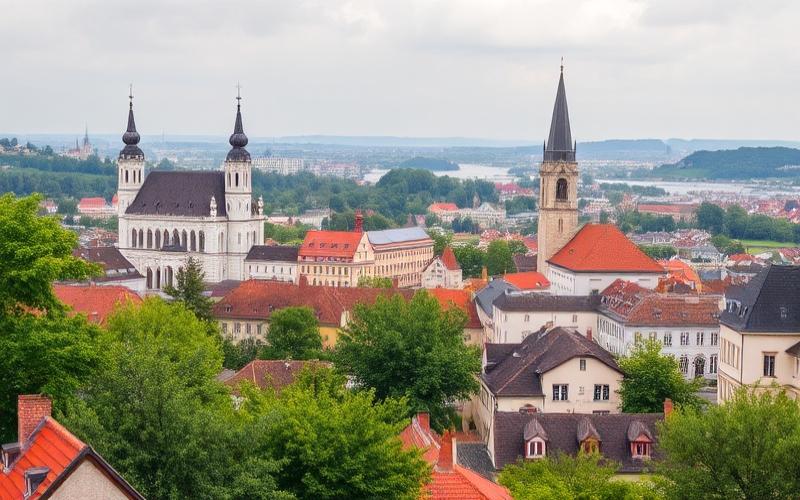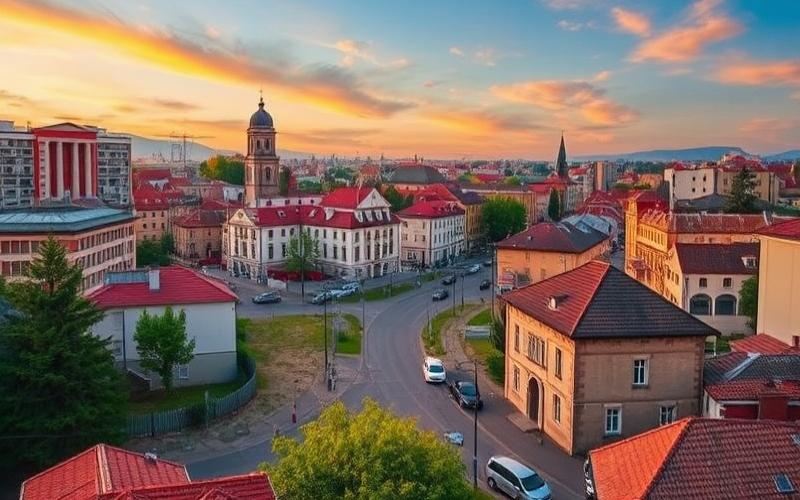
 Published on and written by Cyril Jarnias
Published on and written by Cyril Jarnias
Hungary’s real estate market is undergoing a bold transformation with the rise of co-living spaces, a trend merging innovation and community to meet the needs of a new generation of urban residents.
With growing urban populations, these shared spaces are gaining popularity, offering a flexible and economical solution amid skyrocketing traditional real estate prices.
The collaborative environments they provide don’t just reinvent community living—they also foster a crucial sense of belonging in a society seeking connection.
Exploring this phenomenon in Hungary means entering a world where the boundary between private and shared living is constantly being redrawn.
The Co-Living Spaces Concept: A New Trend in Hungary
Definition and Distinction of Co-Living Spaces
Co-living spaces are modern forms of shared housing where multiple unrelated individuals live together in the same building or apartment. Each resident has private space (typically a bedroom with private bathroom), while common areas (living room, kitchen, workspaces, gyms, terraces, etc.) are shared and designed to encourage social interaction and community building. This model differs from traditional shared housing through professional management, integrated services (cleaning, internet, events, etc.), and a strong emphasis on creating a collaborative community spirit.
| Co-living Space | Traditional Shared Housing | Student Housing |
| Professional management | Self-organized management | Institutional management |
| Included services | Few or no services | Basic services |
| Varied common spaces | Often limited | Simple common areas |
| Curated community | Informal community | Student community |
| Contract flexibility | Rigid contracts | Annual contracts |
Socio-economic Factors Driving Demand in Hungary
- Rising rents and shortage of affordable housing in major cities, particularly Budapest.
- Increased mobility among young professionals, students, remote workers, and expatriates.
- Demand for rental flexibility (short-term contracts, all-inclusive, no long-term commitment).
- Post-pandemic social isolation, creating need for community and mutual support.
- Budapest’s appeal as a technological and cultural hub attracting international talent.
Evolution of Popularity in Hungary
The first co-living spaces appeared in Budapest in the early 2020s, inspired by Western models.
Demand grew rapidly, driven by workplace digitalization, remote work development, and the arrival of international startups.
The COVID-19 pandemic enhanced co-living’s appeal through the combination of private spaces and common areas suited for remote work and social life.
By 2025, the Hungarian market continues growing, with diversified offerings catering to different profiles (young professionals, single-parent families, active seniors).
Notable Co-Living Space Examples in Hungary
| Name | Location | Unique Features | Main Attractions |
| KAPTÁR Coliving | Budapest | Integrated coworking spaces, professional events, international community | Flexibility, networking, urban centrality |
| Urban Lobby | Budapest | Designer rooms, gym, creative workshops, shared garden | Cultural activities, wellness, modern environment |
| Millenáris Coliving | Budapest | Eco-friendly building, green spaces, sustainability workshops | Sustainability, environmental commitment, innovation |
Advantages and Disadvantages for Residents
Advantages:
- Cost reduction: Shared expenses, included services, competitive rents for premium amenities.
- Community: Easy integration, mutual support, group activities, expanded professional network.
- Flexibility: Short-term contracts, no large security deposit, easy relocation options.
- Comfort and services: Access to modern facilities, relaxation and work areas, maintenance included.
Disadvantages:
- Limited privacy: Sometimes overcrowded common areas, need to accommodate others’ habits.
- Community rules: Requirement to follow collective rules and maintain certain discipline.
- Resident turnover: Frequent changes that can affect community stability.
- Potentially higher cost than traditional shared housing if prioritizing independence.
Future Prospects for Co-Living in Hungary
The Hungarian co-living market should continue growing, supported by urban mobility, remote work expansion, and Budapest’s international appeal.
Demographic forecasts indicate increasing urban young professionals and an aging population, paving the way for intergenerational co-living models.
Economic uncertainty could boost demand for flexible, affordable housing, while innovation (hybrid spaces, eco-friendly housing) should diversify offerings.
Main challenges remain regulation, competition with traditional housing, and maintaining high service and community standards.
Co-living thus establishes itself as an innovative, flexible, and community-oriented solution perfectly suited to new urban lifestyles in Hungary.
Good to Know:
Co-living spaces, shared housing designed to foster community while offering living flexibility, distinguish themselves from other types through their inclusive and collaborative structure encompassing both common and private areas. In Hungary, their popularity has grown in response to socio-economic factors like rising real estate prices and young urban populations seeking affordable housing options. Recent years have seen notable projects like KAPTÁR and Community House emerge, offering unique features such as event programs and integrated services. For residents, co-living spaces provide the benefits of shared costs and new social interactions, though privacy may sometimes be limited. With demographic shifts and hoped-for economic recovery, co-living spaces in Hungary could continue thriving, attracting both young professionals and digital nomads seeking flexible lifestyles.
Premium shared housing in Hungary is becoming the preferred housing solution for young professionals seeking flexibility, comfort, and dynamic social life.
Flexibility and Mobility
- Short-term lease options suitable for temporary work assignments or changing circumstances.
- Easy moves with fully furnished housing, allowing quick move-in or departure without complex procedures.
- Often individualized contracts offering freedom to choose ideal stay duration according to needs.
Modern Infrastructure and Included Services
- Access to shared workspaces (coworking), meeting rooms, and quality IT equipment.
- On-site gyms, fitness areas, and relaxation zones integrated into the residence.
- Common areas designed for interaction: equipped kitchens, lounges, terraces, rooftops, game rooms.
| Infrastructure & Services | Description |
|---|---|
| Shared workspaces | Offices, meeting rooms, high-speed wifi |
| Gyms | Fitness equipment, group classes |
| Common areas | Kitchens, lounges, terraces, rooftops, game rooms |
| Included services | Cleaning, maintenance, subscriptions (internet, electricity) |
Balanced Lifestyle and Networking Opportunities
- Common areas and organized events facilitate networking, professional and friendly encounters.
- Environment promoting work-life balance: ability to work, relax, and socialize in the same location.
- Opportunities to expand networks through diverse profiles and regular workshops, after-work events, or themed parties.
Economic and Practical Advantages
- Shared rent, utilities, and subscription costs significantly reducing expenses compared to traditional rentals.
- Budapest shared room prices start around €200 monthly, an attractive alternative to studios or individual apartments with higher rents.
- No hidden fees: most services (internet, electricity, cleaning) included in rent, simplifying budget management.
Testimonials and Growing Popularity
- Specialized platforms report significant demand increase for this housing type among international young professionals.
- Young professional testimonials highlight friendly atmosphere, easy integration, and quality infrastructure.
- Premium co-living offerings multiplying in Budapest and major university cities, illustrating growing appeal of this housing model.
Premium shared housing thus perfectly meets Hungarian and international young professionals’ expectations: flexible, modern, economical housing, and above all, a genuine living environment facilitating both personal fulfillment and career development.
Good to Know:
Premium shared housing increasingly appeals to young professionals in Hungary through its flexibility and practicality; it offers short-term leases and easy relocation perfectly matching their mobility needs. Equipped with modern infrastructure, these spaces often include access to features like coworking areas, gyms, and common zones promoting networking, providing an environment conducive to balanced work-life lifestyles. Beyond economic aspects, cost sharing reduces expenses compared to traditional rentals while enjoying quality living standards. Recent testimonials highlight strong interest growth in these co-living spaces, illustrating their rising popularity in Hungary among young professionals seeking to combine personal development and career in stimulating environments.
Shared spaces in Hungary, supported by digitalization and online platforms, strengthen community bonds among residents by facilitating continuous, structured exchanges. Through high-speed networks (gigabit and 5G), digital connectivity enables seamless access to collaborative and social tools.
Examples of digital applications or services promoting these interactions:
- Private discussion groups on Slack or Discord dedicated to residents exchanging advice, organizing mutual aid, or sharing news.
- Event platforms like Meetup or Eventbrite integrated into daily life for planning video game nights, virtual cooking workshops, or professional webinars.
- Internal applications (e.g., Resident App) enabling common space reservations, technical issue reporting, quick local event organization.
- Community forums hosted on space websites for seeking feedback on collective projects, requesting logistical help, or posting announcements.
Comparison Table — Digital Tools & Uses
| Tool / Platform | Primary Use | Community Impact |
|---|---|---|
| Slack/Discord | Thematic discussions | Strengthening social bonds |
| Meetup/Eventbrite | Event organization | Creating shared moments |
| Internal Resident App | Daily management | Facilitating communal living |
| Local forum | Expression space | Inclusion & participation |
This innovative model strongly attracts young professionals and students seeking:
- Expanded professional networks through cultural diversity (European digital nomads).
- Mentorship opportunities via hubs like EIT Community Hub Budapest connecting local talent with global resources.
- Work organization flexibility and quick adaptation to new collaborative modes.
Observed positive effects:
- Enhanced well-being, through reduced isolation feelings often associated with traditional urban housing; each resident can easily request help or social interaction as needed.
- Personal social network development: Daily exchanges with varied profiles open unexpected collaborations (spontaneous entrepreneurial projects during virtual hackathons).
- Simplified access to digital training, hybrid community workshops blending in-person/virtual participation.
Future perspectives:
- Possible deployment of personalized AI solutions for forum moderation, facilitating connections between complementary skills;
- Growing integration with smart home devices, logistical automation via mobile applications;
- Progressive creation of locally interconnected communities at European level through Hungarian national strategies aiming for near-universal gigabit coverage.
Digitalization thus transforms Hungarian co-living into an innovative lifestyle where community spirit aligns with professional efficiency.
Good to Know:
In Hungary, co-living spaces adopt innovative digital approaches to strengthen community bonds among residents. Through dedicated online platforms, these spaces encourage interactions via discussion groups, virtual events, and shared services. For example, the “HubBudapest” application allows residents to participate in online meditation sessions and organize virtual meetups, fostering a connected and supportive living environment. This model particularly attracts young professionals and students by creating dynamic social networks and supporting collective well-being. By cultivating active digital communities, these co-living spaces provide common ground while respecting individualities, thus facilitating resource and experience sharing. This lifestyle is set to expand, integrating new technologies to further strengthen interpersonal connections and maximize shared residence potential.
Impact of Co-Living Space Growth on Hungarian Real Estate Market
The rise of co-living spaces in Hungary, particularly Budapest, is redefining the real estate market and transforming urban dynamics.
Effects on Real Estate Prices
- Growing co-living demand exerts upward pressure on prices in certain central neighborhoods, where housing supply is already limited due to strict regulations protecting historical heritage.
- Despite relatively affordable absolute prices, they remain high compared to local purchasing power. Co-living development attracts more foreign investors, contributing to this disconnect between local wages and property values.
- By limiting new construction and renovating existing buildings for co-living, traditional supply remains constrained, thus supporting land valuation.
Impact on Rental Demand
- Co-living meets strong rental demand among Hungarian young professionals and especially expatriates (digital nomads, Erasmus students), who prioritize flexibility and included services (cleaning, community events).
- This model also appeals to those deterred by traditional rents or seeking more social lifestyles. Rapid occupant turnover supports high occupancy rates for these residences.
Urban Trends & Development
- Developers invest in transforming existing buildings rather than new construction—a choice driven by local urban constraints but also by desire to revitalize certain neighborhoods.
- Co-living contributes to urban renewal: it introduces more social diversity and generates new forms of common spaces focused on community and social innovation.
| Effect | Hungarian Market | Other European Markets |
|---|---|---|
| Prices | Moderate increase in center | More marked increase (Berlin) |
| Supply | Very limited | More flexible elsewhere |
| Investors | Mostly foreign | Mixed by country |
| Local reaction | Cautious but growing | Already well-established |
Reception by Local Population & Investors
- Hungarian young professionals show growing interest in this innovative housing model; however, their participation remains limited by financial means. For many, it’s mainly a temporary or transitional solution before traditional purchase or rental.
- European institutional investors show strong enthusiasm: nearly 51% consider investing in this sector soon.
Implications for Traditional Property Owners
- Advantages:
- Opportunity to convert unattractive older properties into profitable shared residences
- Disadvantages:
- Increased competition against models offering more services
- Potential risk if regulations evolve against these structures
Economic & Social Aspects
Economic: Offerings adapted to tight budgets of young workers/students while ensuring higher profitability than traditional rentals through cost sharing.
Social:
- Facilitates rapid expatriate integration
- Strengthens community feeling through shared spaces (common kitchen, lounges)
- May indirectly help limit urban isolation
Broader European Comparison
Throughout Western Europe—particularly Berlin or Lisbon—similar dynamics are observed:
- Phenomenon acceleration under combined effects of post-COVID mass remote work,
- Growing difficulties with traditional home ownership,
- Leading role for mobile/international populations.
However:
In Budapest, the movement is hindered by:
- Limited stock,
- Conservative legislation protecting old buildings,
- Less enthusiastic local reception than Berlin or Amsterdam where this offering became dominant solution for all demographics.
Co-living thus represents major innovation still selective in scope: it energizes certain segments while remaining dependent on local economic context—particularly visible in Hungarian market where its growth navigates between strong heritage traditions and emerging needs linked to new urban lifestyles.
Good to Know:
The rise of co-living spaces in Hungary leads to significant real estate market reorientation, particularly with notable rental demand increase in urban areas. This concept, well-received by young professionals and expatriates, causes real estate price increases, especially in neighborhoods popular for these shared living spaces. Real estate developers adapt their projects by integrating more community areas, thus influencing urban development trends. However, traditional property owners may feel pressure to reduce prices or renovate to remain competitive. Compared to other European countries like Germany or Netherlands, Hungary shows growing interest in these spaces meeting new generations’ flexibility and community needs. These spaces also promote growing sharing economy, enhancing social interactions and providing affordable solutions amid rising living costs.
Disclaimer: The information provided on this website is for informational purposes only and does not constitute financial, legal, or professional advice. We encourage you to consult qualified experts before making any investment, real estate, or expatriation decisions. Although we strive to maintain up-to-date and accurate information, we do not guarantee the completeness, accuracy, or timeliness of the proposed content. As investment and expatriation involve risks, we disclaim any liability for potential losses or damages arising from the use of this site. Your use of this site confirms your acceptance of these terms and your understanding of the associated risks.

















































